Long noncoding RNA repertoire and targeting by nuclear exosome, cytoplasmic exonuclease, and RNAi in fission yeast
- PMID: 29914874
- PMCID: PMC6097657
- DOI: 10.1261/rna.065524.118
Long noncoding RNA repertoire and targeting by nuclear exosome, cytoplasmic exonuclease, and RNAi in fission yeast
Abstract
Long noncoding RNAs (lncRNAs), which are longer than 200 nucleotides but often unstable, contribute a substantial and diverse portion to pervasive noncoding transcriptomes. Most lncRNAs are poorly annotated and understood, although several play important roles in gene regulation and diseases. Here we systematically uncover and analyze lncRNAs in Schizosaccharomyces pombe. Based on RNA-seq data from twelve RNA-processing mutants and nine physiological conditions, we identify 5775 novel lncRNAs, nearly 4× the previously annotated lncRNAs. The expression of most lncRNAs becomes strongly induced under the genetic and physiological perturbations, most notably during late meiosis. Most lncRNAs are cryptic and suppressed by three RNA-processing pathways: the nuclear exosome, cytoplasmic exonuclease, and RNAi. Double-mutant analyses reveal substantial coordination and redundancy among these pathways. We classify lncRNAs by their dominant pathway into cryptic unstable transcripts (CUTs), Xrn1-sensitive unstable transcripts (XUTs), and Dicer-sensitive unstable transcripts (DUTs). XUTs and DUTs are enriched for antisense lncRNAs, while CUTs are often bidirectional and actively translated. The cytoplasmic exonuclease, along with RNAi, dampens the expression of thousands of lncRNAs and mRNAs that become induced during meiosis. Antisense lncRNA expression mostly negatively correlates with sense mRNA expression in the physiological, but not the genetic conditions. Intergenic and bidirectional lncRNAs emerge from nucleosome-depleted regions, upstream of positioned nucleosomes. Our results highlight both similarities and differences to lncRNA regulation in budding yeast. This broad survey of the lncRNA repertoire and characteristics in S. pombe, and the interwoven regulatory pathways that target lncRNAs, provides a rich framework for their further functional analyses.
Keywords: NMD pathway; RNA degradation; Schizosaccharomyces pombe; antisense RNA; cytoplasmic exonuclease; pervasive transcription.
© 2018 Atkinson et al.; Published by Cold Spring Harbor Laboratory Press for the RNA Society.
Figures
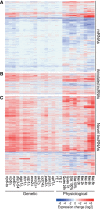

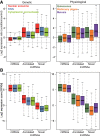
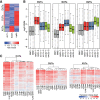
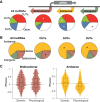
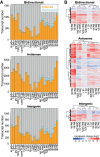

Similar articles
-
Endogenous RNAi pathway evolutionarily shapes the destiny of the antisense lncRNAs transcriptome.Life Sci Alliance. 2019 Aug 28;2(5):e201900407. doi: 10.26508/lsa.201900407. Print 2019 Oct. Life Sci Alliance. 2019. PMID: 31462400 Free PMC article.
-
Nonsense-Mediated Decay Restricts LncRNA Levels in Yeast Unless Blocked by Double-Stranded RNA Structure.Mol Cell. 2016 Feb 4;61(3):379-392. doi: 10.1016/j.molcel.2015.12.020. Epub 2016 Jan 21. Mol Cell. 2016. PMID: 26805575 Free PMC article.
-
The fission yeast MTREC complex targets CUTs and unspliced pre-mRNAs to the nuclear exosome.Nat Commun. 2015 May 20;6:7050. doi: 10.1038/ncomms8050. Nat Commun. 2015. PMID: 25989903 Free PMC article.
-
[RNAi and the formation of heterochromatin in Schizosaccharomyces pombe.].J Soc Biol. 2007;201(4):401-10. doi: 10.1051/jbio:2007901. Epub 2008 Mar 5. J Soc Biol. 2007. PMID: 18533101 Review. French.
-
Transcriptional interference at tandem lncRNA and protein-coding genes: an emerging theme in regulation of cellular nutrient homeostasis.Nucleic Acids Res. 2020 Sep 4;48(15):8243-8254. doi: 10.1093/nar/gkaa630. Nucleic Acids Res. 2020. PMID: 32720681 Free PMC article. Review.
Cited by
-
LncRNA-NEAT1 from the competing endogenous RNA network promotes cardioprotective efficacy of mesenchymal stem cell-derived exosomes induced by macrophage migration inhibitory factor via the miR-142-3p/FOXO1 signaling pathway.Stem Cell Res Ther. 2020 Jan 21;11(1):31. doi: 10.1186/s13287-020-1556-7. Stem Cell Res Ther. 2020. PMID: 31964409 Free PMC article.
-
Comparative analysis of RNA enrichment methods for preparation of Cryptococcus neoformans RNA sequencing libraries.G3 (Bethesda). 2021 Oct 19;11(11):jkab301. doi: 10.1093/g3journal/jkab301. G3 (Bethesda). 2021. PMID: 34518880 Free PMC article.
-
Pervasive mRNA uridylation in fission yeast is catalysed by both Cid1 and Cid16 terminal uridyltransferases.PLoS One. 2023 May 23;18(5):e0285576. doi: 10.1371/journal.pone.0285576. eCollection 2023. PLoS One. 2023. PMID: 37220133 Free PMC article.
-
Ageing-associated long non-coding RNA extends lifespan and reduces translation in non-dividing cells.EMBO Rep. 2024 Nov;25(11):4921-4949. doi: 10.1038/s44319-024-00265-9. Epub 2024 Oct 2. EMBO Rep. 2024. PMID: 39358553 Free PMC article.
-
Growth-rate-dependent and nutrient-specific gene expression resource allocation in fission yeast.Life Sci Alliance. 2022 Feb 28;5(5):e202101223. doi: 10.26508/lsa.202101223. Print 2022 May. Life Sci Alliance. 2022. PMID: 35228260 Free PMC article.
References
Publication types
MeSH terms
Substances
Grants and funding
LinkOut - more resources
Full Text Sources
Other Literature Sources
Molecular Biology Databases
